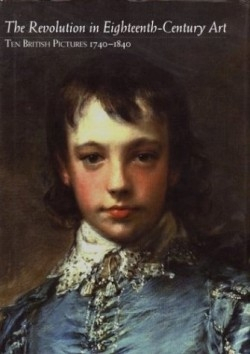
The Revolution in Eighteenth-Century Art
Ten British Pictures, 1740-1840
For anyone with only fading memory (or not even a palette to perch on), when it comes to British art of the period 1740-1840, this elegant, incisive, far-ranging yet concise book will come as a godsend. More than that, it will open the doors of perception. The author states that for painting, this period was “with little doubt the most brilliant in British history.” By the 1750s, the virtually pan-European rococo style of painting (“leading the eye a kind of wanton chase”) was in decline and the “general stylistic coherence” it imposed was no longer to be found. Instead, revolutionary new elements governed subject and treatment in painting.
In his crystal-clear, eye-opening analysis and discussion of ten paintings (some world-famous, others less well known), Wark presents historical, contextual, and critical information with engaging conversational immediacy. The topic paintings are reproduced full-page, in color. Wark demonstrates key findings, makes contrasts, and illustrates a painter’s development, technique, and style, using an additional one hundred paintings, reproduced in smaller sizes. These illustrations provide a rich visual resource for every reader. It should be noted that all the paintings hang in the Huntington Gallery, and that http://www.huntington.org provides access to a wealth of images and information, as does John Brewer’s The Pleasures of the Imagination (1997).
Wark’s core analyses focus on how the painters and paintings were, in their distinctly different ways, “revolutionary.” They were not preaching revolution, but were breaching the conventions of the rococo, seeking depth rather than surface, reflecting the changed social perceptions of a confident nation, yet (at least in portraiture) making a referential nod to the symbols of continuity, status, and social validation. What will most surprise and satisfy the reader is how broad a range of insights and commentary on society, manners, and mentalities can be offered by ten well-chosen paintings-and how engagingly Wark gathers and shares that harvest.
The six portraits are intensely alive. Hogarth’s somber Bishop Hoadly reflects the prelate’s interest in worldly rewards; Gainsborough’s The Blue Boy (a hardware merchant’s son, murky green prior to cleaning) acquires aristocratic breeding thanks to his Van Dyck costume; Reynolds’s Mrs. Siddons as the Tragic Muse gains added dignity through selected symbols; Lawrence’s Pinkie meaningfully conveys a probably absent vitality. In contrast, Rowlandson’s Mrs. Siddons Rehearsing hints at the popular cartoon, while Blake’s Satan, Sin and Death reflects the writer-illustrator-mystic as painter. These broad-brush comments do not of course replicate Wark’s discussion of each painting’s place within the artist’s oeuvre, or capture contemporary comment on the paintings, as he so successfully does.
Given Wark’s commentary, the three very different landscapes yield great reward. Wilson’s River Scene with Bathers is—to an extent—remote, Elysian, and idealized (“golden light” suffuses the painting?); the idyllic scene, with its ruined temple on the crag, comforts the viewer. Gainsborough’s The Cottage Door, on the other hand, offers idealized, babe-in-arms rustic domesticity as reflected in the writings of Goldsmith, Rousseau, and others who never suffered rural reality but depicted health and happiness in untrammeled simplicity. Wark notes the many notebook sketches and the acute observation that underlay Constable’s representational, tranquil View on the Stour near Dedham, painted in different versions at different times. Last, in Turner’s Grand Canal, Venice, the author analyzes the artist’s technical skills in manipulating architectural masses, distance, and perspective in his magnificent paintings-and notes a propensity for classical quotations.
In noting that the old coherence and commonality in art had dissolved, Wark places artists and the Royal Academy within their social context in a newly confident and prosperous Britain, and examines a new world of public taste and artist-client relationships. Of great interest are the artists’ social and educational backgrounds, their entry into the profession, and the rise and fall of their reputations in their own day. Wark also explores the birth and early history of the selected paintings, and notes that for some, their initial reception was unenthusiastic.
Robert Wark was Curator of the Huntington Art Collections from 1956 to 1990. He writes from the heart and from intimate knowledge of his subject. It would be difficult to imagine a more readable or rewarding book on its topic than this volume; it confirms how powerfully the expert can assist the amateur.
Reviewed by
Peter Skinner
Disclosure: This article is not an endorsement, but a review. The publisher of this book provided free copies of the book to have their book reviewed by a professional reviewer. No fee was paid by the publisher for this review. Foreword Reviews only recommends books that we love. Foreword Magazine, Inc. is disclosing this in accordance with the Federal Trade Commission’s 16 CFR, Part 255.
